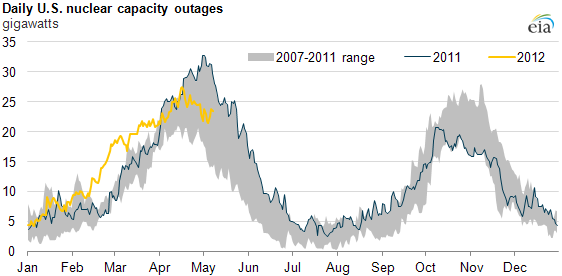
U.S. nuclear outages back within five-year range

U.S. nuclear outages peaked above 27 gigawatts on April 16 due to the combination of seasonal refueling outages and several forced outages. U.S. nuclear reactor operators typically schedule refueling and maintenance outages for the spring and fall to help ensure that reactors are available to meet higher electric demand levels in the summer and winter.
Nuclear outages in 2011 were unusually high through the first half of the year and part of the fall due to the confluence of the refueling season and several forced outages, including outages resulting from weather events (such as tornadoes or flooding). Nuclear outages in late February and March 2012 were above the 2011 level because of a combination of refueling and forced outages in mid-to-late February and into March.
Some notable units in extended outage include:
- Southern California Edison's San Onofre Units 2 and 3 near San Diego, California, have both been offline since January 31 as a precaution after a steam generator tube leak on Unit 3 and the discovery of excessive wear in the Unit 2 steam generators. Initially, Unit 2 was brought offline for a refueling outage on January 9 and has remained offline while repairs are conducted.
- Pacific Gas and Electric's Diablo Canyon Unit 1 near Avila Beach, California was shut down April 23 for refueling and maintenance. Diablo Canyon Unit 2 was taken offline on April 27 due to an influx of sea salp, a small jellyfish-like organism, in the water intake but has since returned to 100% power output.
- Progress Energy Florida's Crystal River Unit 3 has been offline since September 2009 to repair the reactor containment. After evaluating whether the unit should be repaired, Progress announced it will spend $0.9 billion to $1.3 billion to bring the unit back online in 2014.
- Omaha Public Power District's (OPPD) Fort Calhoun reactor initially went offline on April 10, 2011 due to flooding on the Missouri River and has remained down while the U.S. Nuclear Regulatory Commission inspects the plant. OPPD recently presented an Integrated Performance Improvement Plan in response to the flooding.
Tags: capacity, electricity, generating capacity, nuclear, outages